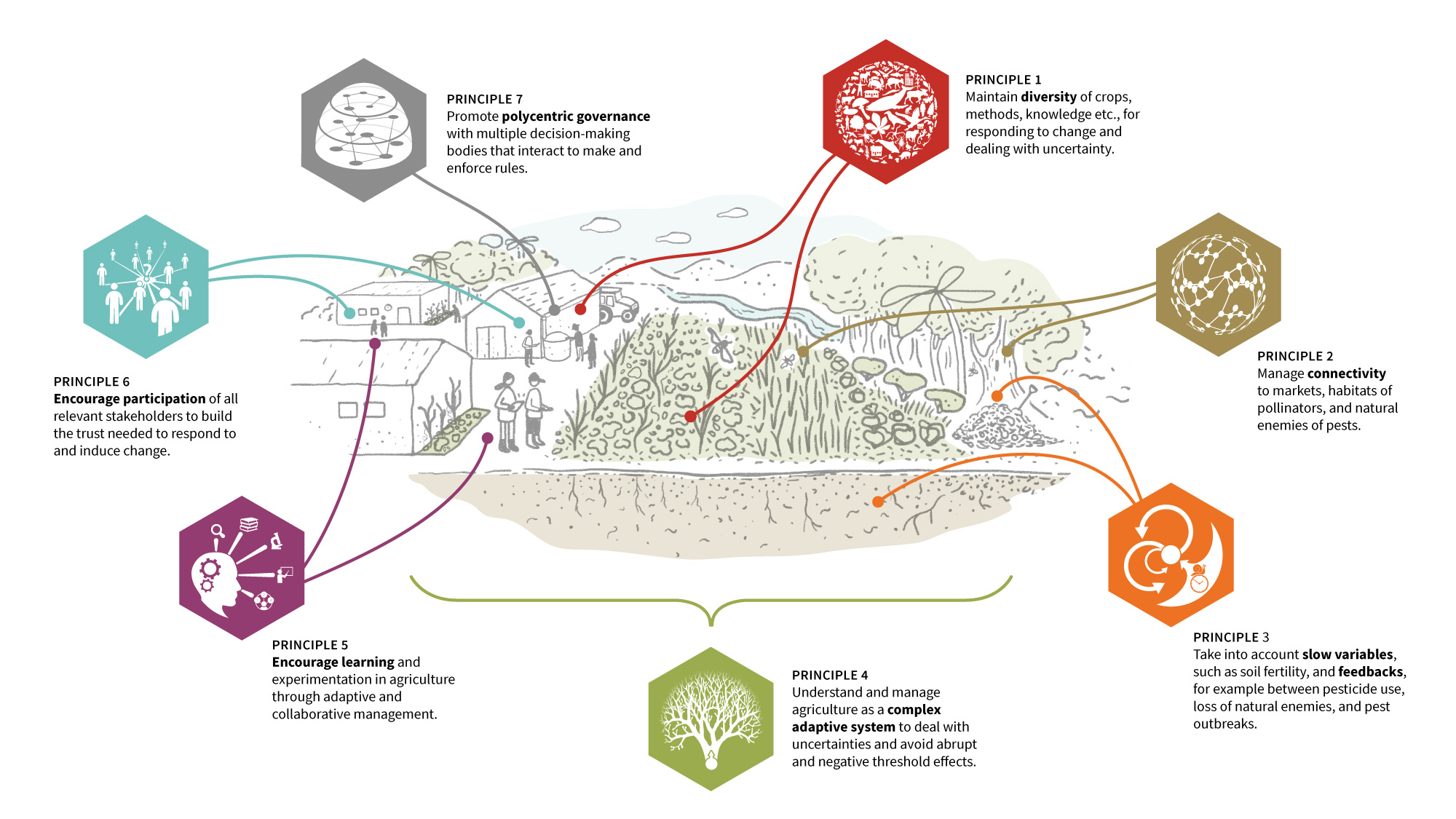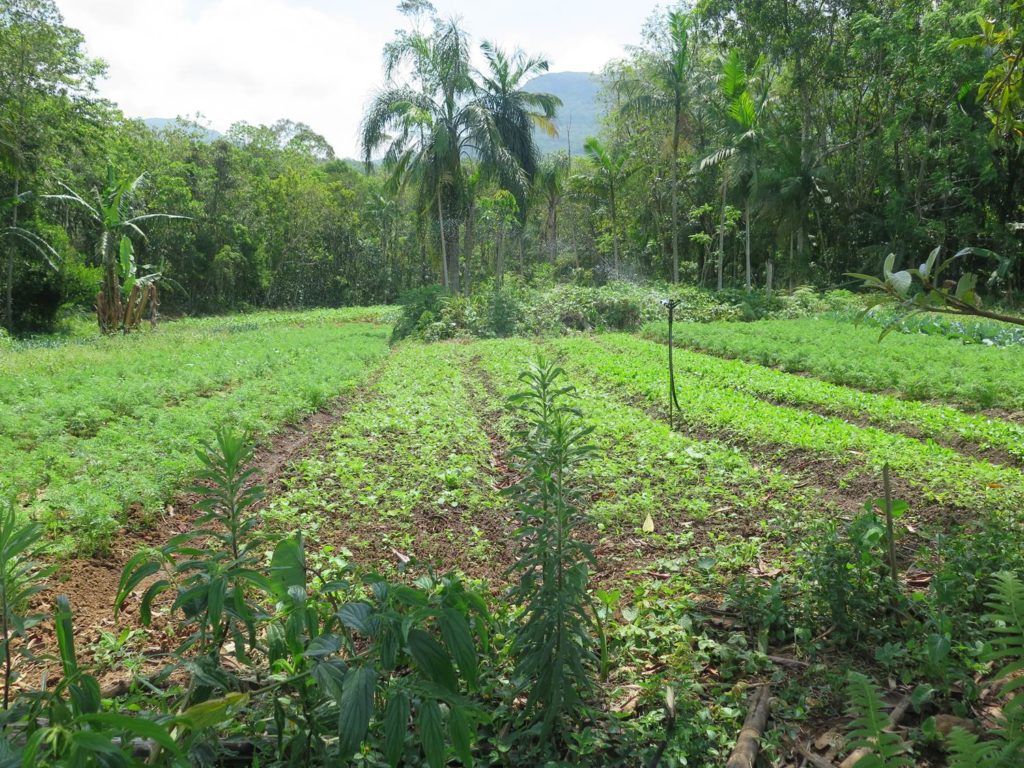Twelve years ago, in 2006, Haregu Gobezay was unemployed and her family with six children relied on her husband’s salary to cover all their expenses. Today, Gobezay and her husband manage a 12-hectare farm with mango, orange, mandarin, and avocado plantations in Mereb Leke District of the Tigray Region in northern Ethiopia. They also keep a few dairy cows, and chickens for egg production.
They no longer rely on a single crop. The finger millet they used to grow often suffered from weed invasions and termites, and the yield was low due to thin and nutrient-poor soils. Now they grow a wide range of different crops. This has helped them tackle many challenges, and made it possible for them to employ almost a hundred people and make a good profit from selling mango and other fruits.
Agroecology has the explicit goal of strengthening the sustainability of all parts of the food system, from the seed and the soil, to the table, including ecological knowledge, economic viability, and social justice.
Gobezay started with planting vegetables; she then added fruit trees, and peanut plants as cover crops that fertilise the soil by fixing nitrogen from the air, with the help of bacteria living in their root systems. Eventually, she brought in dairy cows and started cultivating pasture plants such as alfalfa, Rhodes grass, and elephant grass under the trees.
To improve soil fertility further and to increase soil organic matter, the family now prepares compost in 20 big pits. In addition, a biogas plant on the dairy farm produces bio-slurry compost and energy for cooking.
The family also uses “push-pull” technology as an additional source of income. The technology was developed in Africa to control Striga weeds and insect pests, particularly stemborer moths, without using chemical pesticides. It involves growing maize, sorghum or mango trees together with flowering plants such as Desmodium that repel, or “push”, the pests, and planting other plants such as elephant grass around the crops to attract, or “pull”, the pests. Desmodium eliminates Striga weeds and repels the stemborers, which are instead attracted to the elephant grass. By growing Desmodium, the family’s farm has become a source of seeds for scaling up the push-pull technology in the whole region.
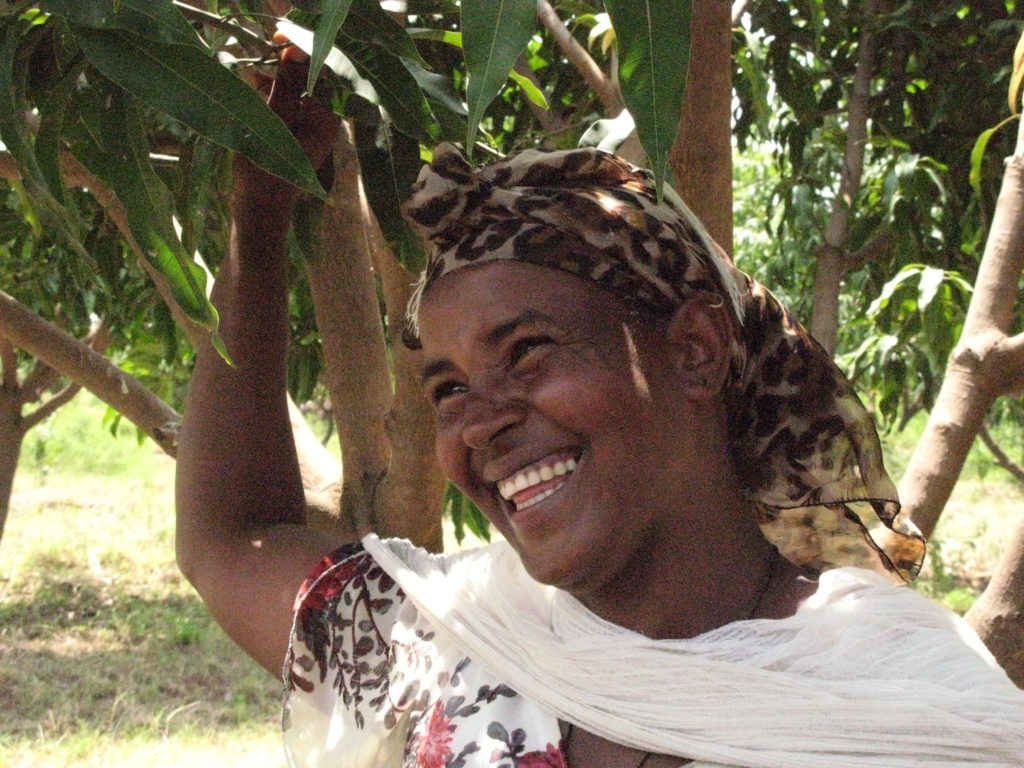
Haregu Gobezay runs an agroecological farm in Ethiopia. Photo courtesy of A. Gonçalvés
More and more farmers around the world are turning away from chemical-intensive single-crop farming in favour of production methods based on diversity, local inputs of for example compost, and ecosystem services. This kind of “agroecological” farming has seen a revival in recent years as a response to the many challenges facing agriculture globally. There is growing evidence that agroecological farming systems keep carbon in the ground, support biodiversity, rebuild soils, and sustain yields, providing a basis for secure livelihoods.1 1. IPES-Food. 2016. From uniformity to diversity: a paradigm shift from industrial agriculture to diversified agroecological systems. International Panel of Experts on Sustainable Food systems. Link to report See all references
Today’s agriculture produces enough food for the global population, but it has not given everyone everywhere access to sufficient, safe, and nutritious food. Agriculture has also contributed to soil degradation, a misuse of natural resources, and the crossing of crucial planetary boundaries that have kept Earth in a relatively stable state for the past 11,000 years, since before agriculture was invented.
Agriculture takes up almost 40% of the planet’s ice-free land surface, accounts for 70% of the freshwater used in the world, and produces about 30% of global greenhouse gas emissions.2 2. Jonathan A. Foley, Navin Ramankutty, Kate A. Brauman, Emily S. Cassidy, James S. Gerber, Matt Johnston, Nathaniel D. Mueller, Christine O´Connell, Deepak K. Ray, Paul C. West, Christian Balzer, Elena M. Bennett, Stephen R. Carpenter, Jason Hill, Chad Monfreda, Stephen Polasky, Johan Rockström, John Sheehan, Stefan Siebert, David Tilman & David P. M. Zaks. (2011) Solutions for a cultivated planet. Nature. doi:10.1038/nature10452 Link to article See all references The current food production system increases humanity’s dependency on fossil fuels and contributes to climate change. Meanwhile, climate shocks and extreme weather events can cause food price volatility that affects both consumers and producers around the world – hitting hardest in poor countries.
The agricultural system has also doubled the flows of nitrogen and phosphorus around the world predominantly through the use of chemical fertilisers, causing severe water quality problems in rivers, lakes, and the ocean. It is also the single biggest driver of biodiversity loss. A growing number of international studies and assessments stress that more attention, public funds, and policy measures should be devoted to the agroecological approach in order to avoid these negative environmental impacts.3-7 3. Altieri, M.A., Nicholls, C.I., Henao, A., Lana, M.A., 2015. Agroecology and the design of climate change-resilient farming systems. Agron. Sustain. Dev. 35, 869–890. doi:10.1007/s13593-015-0285-2 4. AASTD, McIntyre, B.D. (Eds.), 2009. Synthesis report: a synthesis of the global and sub-global IAASTD reports, Agriculture at a crossroads. Island Press, Washington, DC. 5. De Schutter, O. 2010. Report submitted by the Special Rapporteur on the right to food to the Human Rights Council at the Sixteenth session of the UN General Assembly, 20 December 2010. United Nations, New York. 6. UNCTAD, 2013. Trade and Environment Review 2013: Wakeup before it is too late. Make agriculture truly sustainable now for food security in a changing climate. UNCTAD, Geneva. 7. FAO, 2015. Agroecology for Food Security and Nutrition Proceedings of the FAO International Symposium 18-19 September 2014, Rome, Italy. Link to document See all references
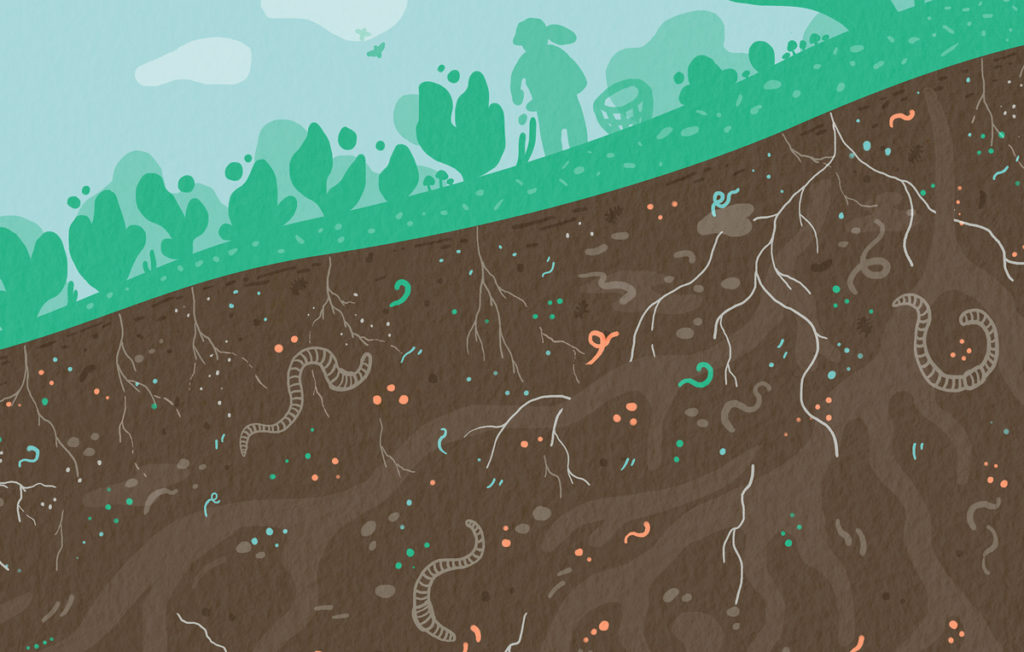
Biodiverstiy is key for soil health and fertility, and resilience. A multitude of organisms inhabit the soil, decomposting organic matter and making nutrients available. Illustration: E. Wikander/Azote
Strengthening the resilience of farmers
Agroecology is the “ecology of the food system”8 8. C. Francis, G. Lieblein, S. Gliessman, T. A. Breland, N. Creamer, R. Harwood, L. Salomonsson, J. Helenius, D. Rickerl, R. Salvador, M. Wiedenhoeft, S. Simmons, P. Allen, M. Altieri, C. Flora & R. Poincelot (2008) Agroecology: The Ecology of Food Systems, Journal of Sustainable Agriculture, 22:3, 99-118, DOI: 10.1300/J064v22n03_10 See all references and a farming approach that is inspired by natural ecosystems. It combines local and scientific knowledge and applies ecological and social approaches to agricultural systems, focusing on the interactions between plants, animals, humans, and the environment. Agroecological methods can also help farmers cope with climate change by enhancing resilience.
Agroecology has the explicit goal of strengthening the sustainability of all parts of the food system, from the seed and the soil, to the table, including ecological knowledge, economic viability, and social justice. To reach this goal, agroecological methods strive to minimise or exclude the use of fossil fuels, chemical inputs such as fertilisers and pesticides, and large-scale monocropping – cultivation of a single crop on vast tracts of land.
An agroecological approach includes a number of agricultural methods, such as diversification of crops, conservation tillage, green manures, natural fertilisers and nitrogen fixation, biological pest control, rainwater harvesting, and production of crops and livestock in ways that store carbon and protect forests. It also emphasises the importance of local knowledge, farmer empowerment, and socio-economic regulations, such as environmental subsidies and public procurement schemes.
Agroecology has become something of a buzzword in recent years, and the big question is: can agroecological farming feed a global population estimated to reach almost 10 billion people in the coming decades? A growing mound of evidence says yes – the approach can help change the world’s food production for the better, and produce enough food to feed the world.
“Today’s scientific evidence demonstrates that agroecological methods outperform the use of chemical fertilisers in boosting food production where the hungry live – especially in unfavourable environments,” said Olivier De Schutter in 2011, in his role as United Nations special rapporteur on the right to food.
De Schutter and many others have also concluded that agroecology is a good way to increase the resilience of farming systems. But few have really investigated in depth how agroecology and resilience are linked in practice among smallholder farmers around the world.
In 2014 André Gonçalves, a professor of agroecology at Instituto Federal Catarinense in Brazil and technical advisor at Centro Ecológico Brazil, took part in the third international resilience conference in Montpellier in France. He became increasingly fascinated with the concept of resilience and wanted to incorporate it into his work on agroecological farming methods.
After the conference, he decided to organise a series of field trips around the world together with the Swedish Society for Nature Conservation (SSNC) and their partner organisations, to look for practical examples of how agroecological methods affect farmers’ resilience.
The field trips took place over several years and took him to Ethiopia, Kenya, Uganda, the Philippines, Sweden, and various places in his home country Brazil. His travels resulted in new insights into how innovative farmers and organisations have been using agroecological approaches to cope with the challenges of climate change and other disturbances, such as degradation of soils, pest outbreaks, chemical pollution, and escalating prices of chemical inputs such as pesticides and fertilisers.9 9. Goncalves, A., K. Höök, F. Moberg. Applying resilience in practice for more sustainable agriculture – Lessons learned from organic farming and other agroecological approaches in Brazil, Ethiopia, Kenya, the Philippines, Sweden and Uganda. Policy brief. Swedish Society for Nature Conservation. Link to policy brief See all references
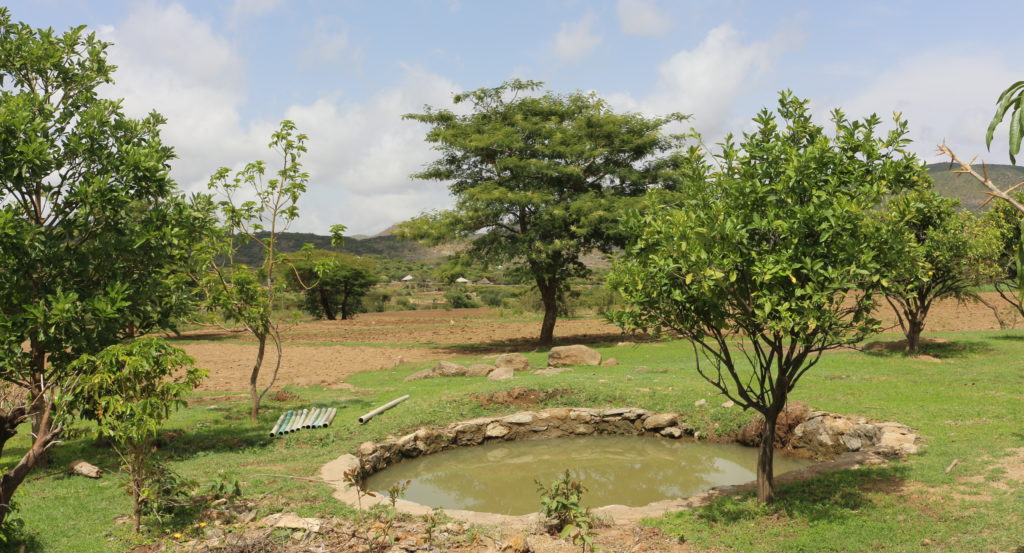
Rainwater harvesting is one important strategy in Ethiopian agroecological farming that builds resilience to drought. Photo: A. Gonçalves.
Connecting agroecology and resilience
Gonçalves quickly concluded that agroecology is not a one-size-fits-all solution, instead it is about taking the local socio-economic and ecological conditions into consideration.
“In my definition agroecology is all about values such as social justice and economic aspects. Otherwise, it would be reduced to the technical dimension,” Gonçalves says. To capture these aspects his analysis focused as much on social and economic measures as on ecological ones to strengthen agricultural resilience.
In 2016 he organised a workshop at the Stockholm Resilience Centre (SRC), gathering practitioners and scientists from around the world to take a closer look at how agroecology and resilience thinking relate to each other. He co-organised the workshop with Karin Höök, a senior consultant and expert in agriculture and environment at NIRAS Sweden. She has collaborated with Gonçalves since the early 2000s. Through her previous work as head of the international department at SSNC, Höök became interested in resilience thinking and how it can be applied to make agriculture more sustainable.
“Resilience theory is extremely interesting and relevant for agricultural development, but it has often come across as more of a popular buzzword than concrete real-world applications,” Höök says. “Now that is changing and we see more and more concrete tools and practical examples of how it can contribute to sustainable agricultural development.”
In 2016, Elin Enfors Kautsky, researcher and research coordinator at the SRC, co-authored a paper suggesting different ways to put resilience-based interventions into practice in agricultural landscapes.10 10. DeClerck, F. A. J., Jones, S. K., Attwood, S., Bossio, D., Girvetz, E., Chaplin-Kramer, B., Enfors, E., Fremier, A. K., Gordon, L. J., Kizito, F., Lopez Noriega, I., Matthews, N., McCartney, M., Meacham, M., Noble, A., Quintero, M., Remans, R., Soppe, R., Willemen, L., Wood, S. L. R. and Zhang, W. 2016. Agricultural ecosystems and their services: the vanguard of sustainability?’, Current Opinion in Environmental Sustainability, 23, pp. 92–99. Link to article See all references The authors concluded that improving ecosystem services and the resilience of agricultural systems to a changing climate, extreme weather events, pest outbreaks, market volatility, institutional changes, and other pressures is critical to achieving a range of the UN’s sustainable development goals.
Following the workshop, where Gonçalves also met Enfors Kautsky, he continued to compare his observations and experiences from the field trips with the seven principles for building resilience,11 11. Biggs, R., M. Schlüter, M.L. Schoon (Eds.). 2015. Principles for building resilience: Sustaining ecosystem services in social-ecological systems. Cambridge University Press, Cambridge. See all references which have become increasingly popular in analysing resilience and putting it into practice. The comparison revealed that certified organic farming and other agroecological approaches often go hand in hand with resilience thinking, and tended to improve both farm revenues and household income. For example, Gonçalves saw many examples of the first resilience principle in the extensive use of diversity of crops, farming techniques, and livelihoods.
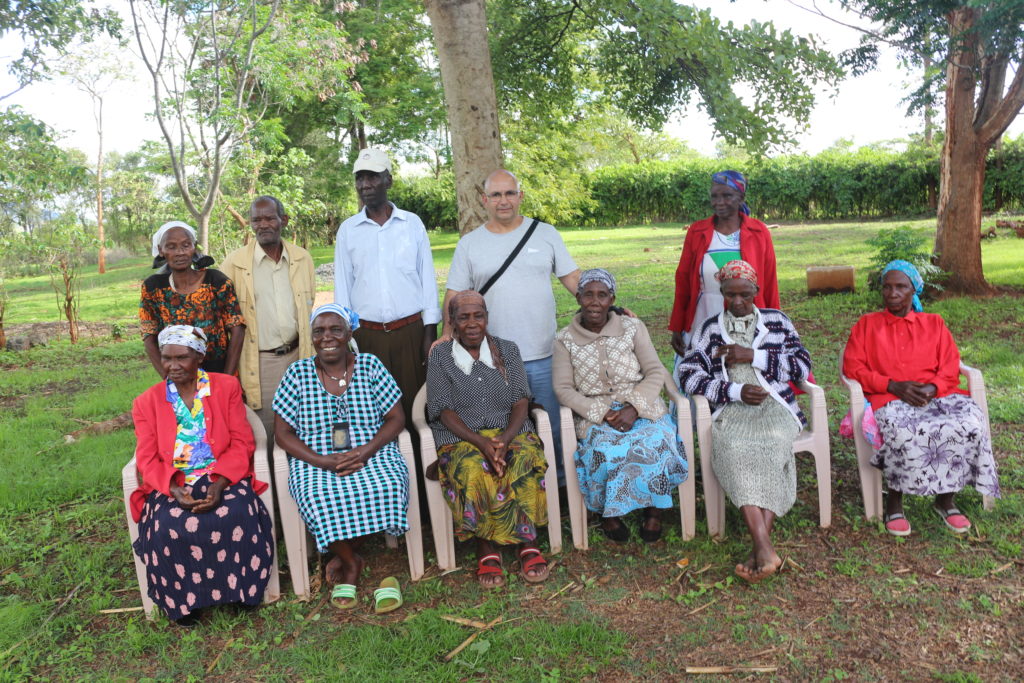
The Tumaini Women Group in the Gatuanyaga Village, Kikuyu community, one of the communities that Andre Goncalves visited during his field trip, is an example of broadened participation, cooperation and social-environmental responsibility to improve living conditions. André Gonçalves is fourth from the left in the back row. Photo courtesy of A. Gonçalves
Building resilience in agroecology
Gobezay and her husband in Ethiopia are by no means the only ones working for a diversity-based farming system. In Uganda, Gonçalves met Vicent Ssonko and Yakubu Nyende, who grow organic pineapples together with bananas and a variety of other plants such as beans, maize, and groundnuts. If the international market for organic pineapples collapses, they will still earn an income from selling bananas at the local market. Beans and groundnuts are important components of a balanced diet, increasing food security and nutrition. They also fixate nitrogen and improve soil fertility, without the need for chemical nitrogen fertilisers.
Diversity is also used to tackle other challenges. Pepito Babasa, a Philippine rice farmer from the Southern Luzon region, often experiences typhoons and floods. He makes sure he plants a diversity of different rice varieties known to withstand floods and droughts to secure his harvest.
The second principle of building resilience – managing connectivity – manifests in many ways in agroecology. Gonçalves found examples ranging from how farmers had access to markets to sell their crops, to the distance of their fields to the habitats of pollinators, and natural enemies of pests. Recycling nutrients and organic matter from one field to another is also an important way of managing connectivity in the agricultural landscape. An example of where this is put into practice can be seen in farmers making and using compost as a natural fertiliser on agroecological farms in Ethiopia. Agroecological methods also support ecological connectivity between the agricultural landscape and the surrounding forests in the Brazilian and Ugandan agroforestry systems that integrate crops, trees, and animal husbandry.
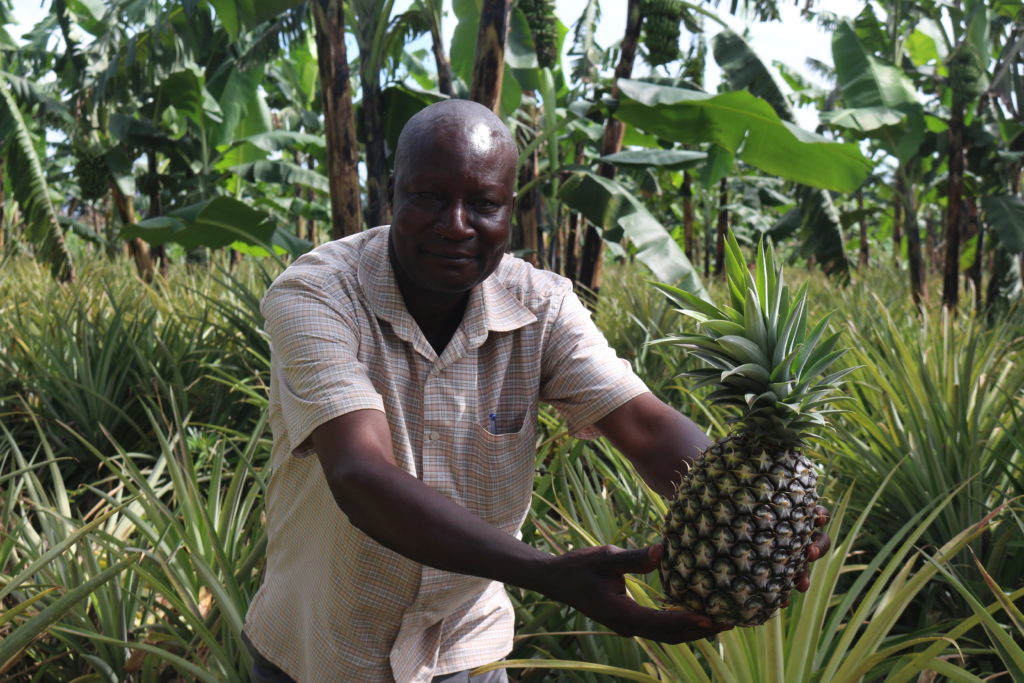
Vicent Ssonko grows organic pineapples together with bananas and a variety of other plants such as beans, maize, and groundnuts. The pinapples are sold on the international market, and bananas on the local market. Beans and groundnuts contain important nutrients for a balanced diet, they also fixate nitrogen and improve soil fertility. Photo courtesy of A. Gonçalvés
Using compost for maintaining the fertility, organic content, and water-holding capacity of soils is also an example of the third resilience principle – managing slow variables and feedbacks. In Ethiopia, the Tigray region’s innovative use of compost has earned world recognition for transforming an area suffering from impoverished soils, erosion, and droughts into increased harvests and incomes while improving groundwater levels, soil fertility, and biodiversity.
Gonçalves also found that farmers had a good understanding of the fourth principle: the landscape as a complex adaptive system. “To adopt agroecological practices simply requires a certain degree of complexity thinking,” he says. “While industrial agriculture is based on a linear approach and a cause and effect relationship, organic and other forms of agroecological agriculture requires a holistic view of agricultural production.”
A plant disease or pest outbreak in industrial agriculture, for example, might be seen as a direct consequence of a virus or insect, and would be controlled by using pesticides. Smallholder agroecological farmers, however, perceive diseases and pests as consequences of management, with many possible causes such as soil fertility, water availability, plant variety, and seasonal shifts.
Learning, participation, and decentralised governance – the fifth, sixth, and seventh resilience principles – were often strongly linked to each other in the farming systems Gonçalves visited. For example, the Ecovida Agroecology Network in Brazil brings together more than 5,000 farmer families in the three southernmost states of the country – Paraná, Santa Catarina and Rio Grande do Sul – in a network that promotes agroecology and sustainable, resilient use of natural resources. The farmers organise peer-to-peer learning and encourage broad participation that includes poor landless smallholders, larger farmers, and food-processing facilities.
The Ecovida network’s structure and distribution is also a classic example of polycentric governance. The network is divided into several self-governing organisations that interact, manage, and enforce rules within certification and sustainable agriculture. All individual members have a vote and all decisions in their respective organisations are taken collectively.
Similar networks connecting learning, participation, and polycentric governance were present in many other places visited by Gonçalves: PELUM is a network of civil society organisations working with grassroots communities in Kenya and nine other African countries; MASIPAG is a farmer-led network of people’s organisations in the Philippines; NOGAMU is an umbrella organisation of producers, processors, and exporters of the organic sector in Uganda; and there were several networks and organisations that promote sustainable farming in Ethiopia and in Sweden.
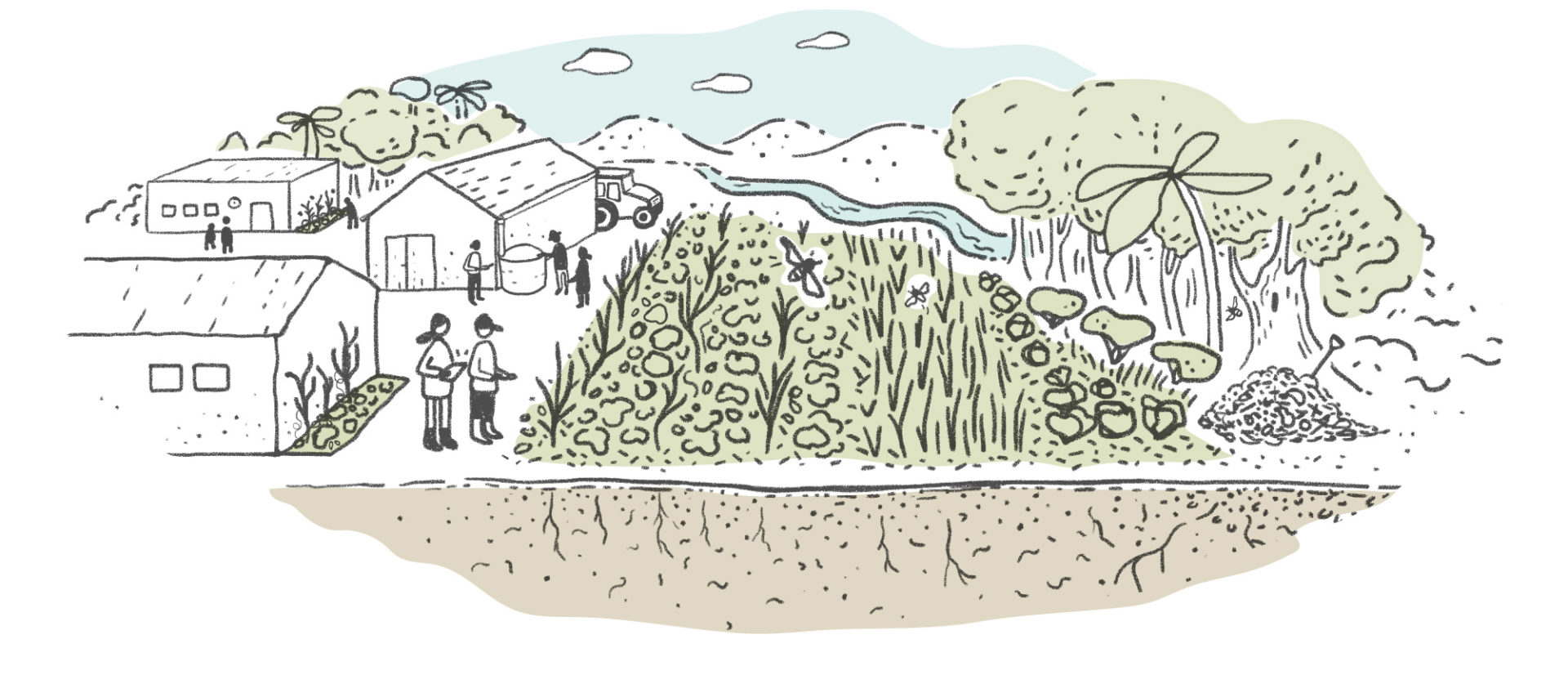
 12 MIN READ / 2958 WORDS
12 MIN READ / 2958 WORDS
